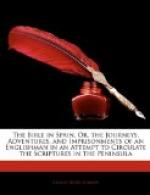The voyage of these narrow seas can scarcely fail to be interesting to the most apathetic individual, from the nature of the scenery which presents itself to the eye on either side. The coasts are exceedingly high and bold, especially that of Spain, which seems to overthrow the Moorish; but opposite to Tarifa, the African continent, rounding towards the south-west, assumes an air of sublimity and grandeur. A hoary mountain is seen uplifting its summits above the clouds: it is Mount Abyla, or as it is called in the Moorish tongue, Gibil Muza, or the hill of Muza, from the circumstance of its containing the sepulchre of a prophet of that name. This is one of the two excrescences of nature on which the Old World bestowed the title of the Pillars of Hercules. Its skirts and sides occupy the Moorish coast for many leagues in more than one direction, but the broad aspect of its steep and stupendous front is turned full towards that part of the European continent where Gibraltar lies like a huge monster stretching far into the brine. Of the two hills or pillars, the most remarkable, when viewed from afar, is the African one, Gibil Muza. It is the tallest and bulkiest, and is visible at a greater distance; but scan them both from near, and you feel that all your wonder is engrossed by the European column. Gibil Muza is an immense shapeless mass, a wilderness of rocks, with here and there a few trees and shrubs nodding from the clefts of its precipices; it is uninhabited, save by wolves, wild swine, and chattering monkeys, on which last account it is called by the Spaniards, Montana de las Monas (the hill of the baboons); whilst, on the contrary, Gibraltar, not to speak of the strange city which covers part of it, a city inhabited by men of all nations and tongues, its batteries and excavations, all of them miracles of art, is the most singular-looking mountain in the world—a mountain which can neither be described by pen nor pencil, and at which the eye is never satiated with gazing.
It was near sunset, and we were crossing the bay of Gibraltar. We had stopped at Algeciras, on the Spanish side, for the purpose of landing the old governor and his suite, and delivering and receiving letters.




